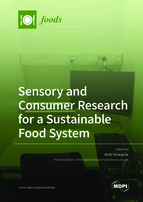Sensory and Consumer Research for a Sustainable Food System
A special issue of Foods (ISSN 2304-8158). This special issue belongs to the section "Sensory and Consumer Sciences".
Deadline for manuscript submissions: closed (30 March 2021) | Viewed by 165307
Special Issue Editor
Interests: aroma; chemosensory perception; consumer behavior; flavor; foods; food quality; food neophobia; genetics; hedonics; individual differences; odor; olfaction; sensory analysis; sustainable food; taste; texture
Special Issue Information
Dear Colleagues,
Sustainability of the food system is one of the key goals of sustainable development. The global population is increasing, while emissions from the food system (together with those from the other sources) should be decreased to limit climate change. The need for more food for less environmental burden calls for novel, innovative solutions for the whole food system. Circularity of the food system must be increased to optimize the use of natural resources, and consequently, many parts of the food system will change. Novel, sustainably cultivated and produced foods are needed. Recently, foods such as plant-based alternatives to meat and dairy products, insects, and single-cell proteins have gained a lot of scientific interest as potential contributors to a sustainable food system. In addition, food waste should be minimized. It is obvious that the supply of foods on the market will change and consumers will face an appeal to change their diet and avoid food waste. These changes in the food system are also providing a plethora of intriguing questions for sensory and consumer researchers to address.
The aim of this Special Issue of Foods is to gather and display cutting-edge research on sensory properties of and consumers’ responses to foods contributing to a sustainable food system. Here, food is defined broadly: from ingredients and prototypes to products on the market, dishes, and even diets. This Special Issue welcomes original research articles and reviews on studies that have used sensory or consumer research to study food or food-related behavior that has the potential to contribute to a sustainable food system. The methods should have either applied human senses to evaluate foods (using trained or non-trained panel) or studied consumers’ responses to foods (such as attitudes or hedonic responses to new sustainable foods). Clear and concisely written manuscripts are highly desirable and appreciated.
Dr. Antti Knaapila
Guest Editor
Manuscript Submission Information
Manuscripts should be submitted online at www.mdpi.com by registering and logging in to this website. Once you are registered, click here to go to the submission form. Manuscripts can be submitted until the deadline. All submissions that pass pre-check are peer-reviewed. Accepted papers will be published continuously in the journal (as soon as accepted) and will be listed together on the special issue website. Research articles, review articles as well as short communications are invited. For planned papers, a title and short abstract (about 100 words) can be sent to the Editorial Office for announcement on this website.
Submitted manuscripts should not have been published previously, nor be under consideration for publication elsewhere (except conference proceedings papers). All manuscripts are thoroughly refereed through a single-blind peer-review process. A guide for authors and other relevant information for submission of manuscripts is available on the Instructions for Authors page. Foods is an international peer-reviewed open access semimonthly journal published by MDPI.
Please visit the Instructions for Authors page before submitting a manuscript. The Article Processing Charge (APC) for publication in this open access journal is 2900 CHF (Swiss Francs). Submitted papers should be well formatted and use good English. Authors may use MDPI's English editing service prior to publication or during author revisions.
Keywords
- Alternatives for meat and dairy products
- Attitudes to new foods (incl. food neophobia)
- Consumer behavior (incl. willingness-to-pay and purchase intentions)
- Food waste reduction
- Hedonic responses (liking, preferences, etc.)
- Labels and such extrinsic cues
- Sensory analysis
- Sensory properties (appearance, odor, taste, flavor, texture)
- Social and cultural aspects of sustainable eating
- Sustainable foods and diets







